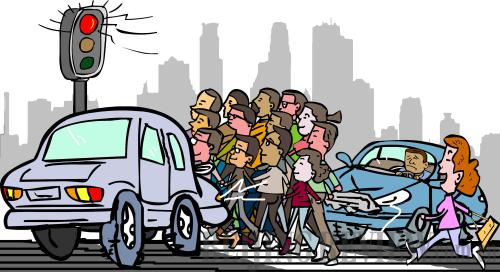|
 |
|
(LI SHIGONG) |
Authorities in Beijing began imposing fines on non-motor vehicles and pedestrians that defy red lights on May 6. The first to run red lights, particularly those who do not cooperate with traffic policemen, will be fined 10 yuan ($1.54).
From the beginning of this year, China began to adopt new traffic rules, which say that pedestrians and non-motor vehicles that run red lights are also to be punished. In the past, jaywalkers were usually exempt from punishment.
Jaywalking can be easily spotted in the country, which has been nicknamed "Chinese-style road crossing" by netizens. The term refers to large crowds of people crossing roads in disobedience of red lights. It reflects the deep-rooted belief that the law will not punish numerous offenders. In busy modern life, some people lack safety awareness and the patience to wait for the light to turn green. The group effect thus takes shape and some basic regulations have been neglected.
The topic of jaywalking has triggered a massive discussion on China's traffic rules and the Chinese public's overall traffic safety awareness. The discussion also raised questions about how long pedestrians should be kept waiting at red lights. The following are excerpts of opinions:
Wang Changjun (China Youth Daily): As early as 2004, China already produced legal regulations on the punishment of jaywalkers. There has long been confusion among the public on whether pedestrians running red lights should be punished in ways such as fines. Today, more people are paying attention to this issue. It is partly because punishment on jaywalkers is made more severe in many places.
Is the public's lack of safety awareness due to the low risk to pay for breaking traffic rules? People defy red lights mostly because they don't take red lights seriously.
Actually, running red lights is a more serious question. Whether it is pedestrians or motor cars, as long as they run red lights, they violate traffic laws, rather than simply traffic regulations.
Will the punishment on jaywalkers be able to deter red light running? Imposing fines is not the ultimate purpose of this new traffic policy. The final goal is to urge all road users to raise their safety awareness, abide by traffic rules and contribute to good traffic orders.
Guo Xiaoge (Nanfang Daily): To impose fines on jaywalkers may further remind pedestrians of obeying traffic rules and the importance of traffic lights. However, it's quite doubtful whether fining will be an effective way of ruling out "the Chinese-style road crossing?"
Ironically, while cities are rushing to fine pedestrians who run red lights, the media is widely revealing that at a 40-meter broad intersection in south China's Guangzhou, the green light for pedestrians only last 5 seconds, which means, pedestrians have to run at a speed of eight meters a second to cover the distance before the light turns red. It is later found that such traffic light design is not seen in Guangzhou. In most cases, pedestrians defy red lights because they have to—they'll easily find that when they have just reached the middle of the road, the traffic light turns red, and if they do not keep walking, they'll be stuck there with autos running past them.
To change the situation, we need to make efforts in two aspects. On one hand, consistent education is important, such as recent fining policy, to remind people of abiding by traffic regulations. On the other hand, urban transport planning must be updated to make it more scientific. Both software and hardware should be stressed and this is likely to be the fundamental way of changing the phenomenon of "Chinese-style road crossing."
Maybe the fining policy will help to improve the situation at intersections, but this will take some time. Imposing fines alone is far from enough to tackle the problem—a scientific planning of urban transport is equally urgent.
| 